
- Other Issues
- >> Freediving and how to get non-divers into enjoying a Dive trip!
- >> Getting Non-Divers into Diving
Adventure Travel now includes Snorkeling/Freediving
 |
Millions of people are choosing vacations today that are "adventure oriented". This article is about the snorkeling/Freediving option many vacationers have not really understood. This option can be as tame and relaxing and beautiful as the scene above... |
 |
...Or it can be even more beautiful and relaxing, but more skill intensive, as in visiting the tiny world of the squat anemone shrimp, pictured at left... |
| ... in their home in a colony of sea anemones, which you could find on the 43 foot deep Breakers Reef crown. This is a place where people, who spend three or four days developing freediving skills from their basic snorkeling skills(with the help of some professional instructors), can aspire to and "learn" to become a "Freediver.... to be able to breathhold dive 40 feet down where they can hang out with some of nature's most fascinating microcosms . | |
| You don't need to be a scuba diver. You DO need to feel comfortable in the water. Lets assume that YOU could be a scuba diver, but your "significant other" is NOT. You want to do things together, but the scuba idea is just "too much" for your partner to commit to. Or, maybe neither of you has ever scuba dived before, you've always had an interest, but "ALL that equipment, ALL that time getting certified, and ALL that expense, has just prevented you from trying scuba so far... |
| What we are talking about here is
showing you away to enjoy much of the very best that scuba diving has to offer,
with some very special EXTRA thrills and feelings as well.
Many people who would try this snorkeling/freediving trip will not have any real snorkeling skills. That means an extra add on to the trip, in the first evening or morning, where you are taught basics in a pool, and you practice these steps with your new equipment, for an hour or two in this non-challenging and controlled environment. |
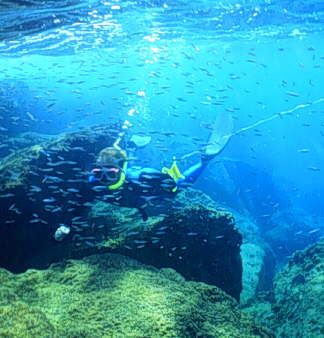 |
Your next step will be a shallow and protected area, filled with massive swarms of small fish and bright colors, and depth ranges between 3 feet deep and 6 feet deep in the first few hundred yards of this site, to 8 feet to 18 feet by the time you reach the end point of this protected area. |
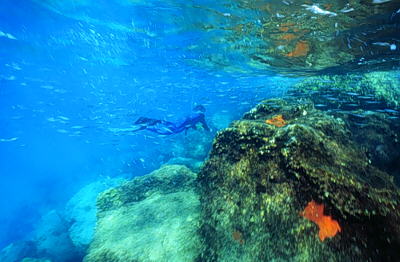 |
It would be your shallow water playground and learning area for at least two days. As you practice your kicking technique, and develop your breathing skills, you find yourself getting down deeper, for longer, and with less effort. |
| Even advanced Freedivers capable of 60 foot breath hold dives enjoy this area immensely. |
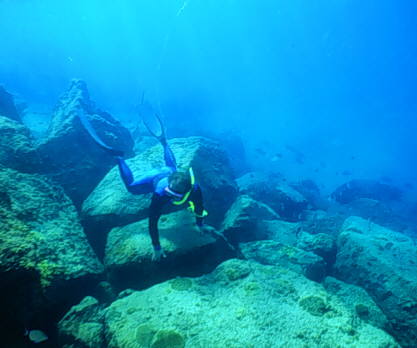 |
The end of this protected area is the point of the south Jetty, on the exclusive Island of Palm Beach. As you develop your skills, diving the very end point here, with the largest schools of fish, the biggest fish, and the larger waves and open seas, you become conditioned to enjoying ever more challenging environments, for the increases in visual excitement more challenging marine environments produce. |
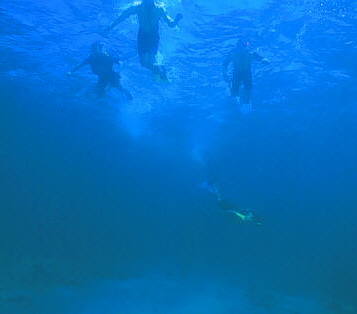 |
Here you will freedive down and peer into caves with sleeping nurse sharks, you will enjoy drifting with a gentle current, and you will begin to dream about trying the greater depths and spectacular sights of the 43 foot deep Breakers Reef. |
To see more photos of the tiny creatures that that South jetty is known for, click here on Macro.
Next stop in your development will be the 12 to 20 foot deep Pink House Reef, parallel to Breakers Reef, but only about 200 yards from shore.
Depending on your group, this may be later the same day, after a rest, or it may be the following day. This will be the day that everything you have been practicing and learning comes together. You have increased your lung capacity by several days of breathing exercises, and you are taking more air in before you do your drops now. You have learned to slow your heart rate, and you and most others in your group are finding they can breath hold comfortably well over 60 seconds...you are chomping at the bit to put this to the test on the Breakers Reef.
Finally the boat drops you above a beautiful section of Breakers Reef, called the Flower Gardens. You begin a slow leisurely kick along the surface. Your long freediving fins have become an extension of your body, and you feel more like a dolphin than a human. Below you, lies your destination....you see a heavily developed canopy of life covering the bottom. Schools of fish blasting around throughout, but they are down there---not up here, or at least not the majority, and you are aching to get up close and personal with the bottom.
Without thinking, you are already breathing very deeply. You have already begun slowing your heart rate.
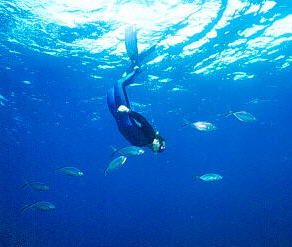 |
And then its time...your lungs are full and your feet are up out of the water, propelling you down, first by gravity, then by slow gentle kicks, tracing very large amplitude strokes, and you relax and almost sleep and fall your way down about 20 feet. |
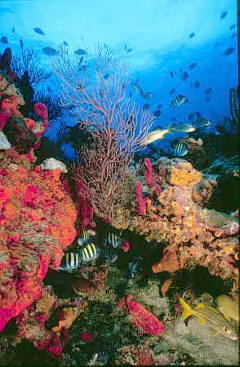 |
You find yourself falling without effort, has you even with a large ledge outcropping and some major activity by schooling fish all around you.You try to relax and go into your deepest meditative state, becoming "one" with the eco-system around you. Your heart rate drops even lower, and you find yourself plugged into a new microcosm of life---before your eyes new understanding and emotion floods into you as you begin to "feel" the lives of the tiny inhabitants you are watching. |
| You see everything much clearer from this distance
from the bottom, but you've been told to work your way down the first few
drops, starting at 10 or 15, then 20, then 30, and then finally all the way
down. This will keep you comfortable, it will help acclimate your body to
slowing everything down and going deeper, and it will give you confidence that
you can get back up easily, since you are gradually working your way
down.
So you drift along for awhile at 20 feet, and then make a leisurely return to the surface. After about 5 more of these little "step" dives, you breathe deep, relax maximally, and head for the bottom. |
| And then it is time to head slowly back to the
surface, maintaining your state of complete relaxation, and propelling your
self by slow, large amplitude kicks which bring you easily back to the surface.
As you "broach" like a dolphin, you allow the air in your lungs to explode out through your snorkel, clearing all water as if it was never there, and then begin to deeply bring in the sweetest smelling air you have ever experienced. You enjoy this deep breathing for another minute, and then the anticipation of getting back down sets you up for your next drop to bottom. |
 |
Now you are beginning do decide what it is you want to look for---do you want to hang out with a family a small brightly colored wrasses at their home in a large barrel sponge, or would you prefer shadowing that 4 foot long barracuda, who is hanging out himself in front of a small ledge, and is now in the process of having himself worked on by a cleaner shrimp---do you think you can swim down slowly and relaxed enough to get close to him and watch, without scaring him away? |
 |
If Sea Turtles are something you are fascinated by, we have included a link out of this article into a past issue devoted to Sea Turtles.. If you click on this link, you will move to the Sea Turtles issue of SFDJ.... |
| Or maybe you want to start cruising, at about 20 feet down, trying to spot a big sea turtle sleeping in a ledge overhang---once you find him, doing a series of drops all the way down to him to visit. |
...it won't show you freediving or snorkeling , but 98% of it was shot in the area of Breakers Reef where freediving is most enjoyable, and marine life and colors are spectacularly vibrant and far beyond what would be experienced in the more "sterile" environments of Grand Cayman or most other Caribbean Islands...But please remember how to find your way back here :) |
| After a day of freediving the 43 foot deep Breakers Reef, you may feel ready to try photography, video, or maybe shell collecting. |
If this snorkeling/freediving scenario appeals to you, obviously its something you need to try soon. Palm Beach is not your only option, but its an excellent one, with far more activities to do "AFTER" diving than virtually any Caribbean spot. We are including a link here to a magazine on the net known as Palm Beach On-Line----it is all about what to do in Palm Beach when you are NOT diving---nightclubing, restaurants, arts and culture, an enormous collection of things to do....but again, PLEASE REMEMBER YOUR WAY BACK HERE!!! |
Figure on late spring and summer hotel rates at between $45 and $65 per night, and if you go in a group you can double up and save here..,and plan on your dive instructor getting $20 per day from each group member, and boat costs of between $25 and $35 per day, depending on the number of people you want to be with---plan on $35 per day to be on a boat with only 5 other paying passenger/snorkellers, or $25 per day to be on a boat with up to 24 snorkelers/divers . |
On receiving your reservation, you will receive a detailed breathing exercise series to perform prior to your trip, as well as heart rate modification program, and some drills to drastically accelerate your abilities in the water once you get here. |
And we would also urge you to acquire or purchase "REAL" freediving gear. The majority of snorkeling trips that tourists are taken on involves the tourists being given the "WORST QUALITY MASKS, SNORKELS AND FINS THEY COULD POSSIBLY USE!!!, normally because the purchase price for the cattle boat was only a few dollars per snorkeling set. If you were going to take a bicycle trip around France, or across Colorado, or some other beautiful but expansive area----we would hope you would either borrow, already own, or buy a good bicycle---typically a $700 to $1500 proposition. For snorkeling/freediving, you have three basic needs, and a 4th that's a good idea. |
You need a VERY good low volume mask that fits perfectly and DOES NOT LEAK! This should cost between $35 and $65. It should be Black silicone, NOT the clear silicone many shops like to sell. You need a J shaped snorkel ...It CAN NOT have a flexible hose built in (they stink, functionally), and they CAN NOT have a built in purge (this is mostly a gimmick to run the price up from the $15 to $20 a good snorkel should cost, to as much as $70 for expensive junk that leaks constantly and is just more drag in the water. Trust us, a good simple J shape, non purge snorkel is superior---don't let any shop sell you otherwise. |
For fins you need the long blade freediving fins. There are really only three brands to consider: AB Biller, Cressi Rondine Gara, and Esclapez Blue (soft ) or Esclapez Green (standard rigidity). The fins should be purchased as full foot fins, not open heel w/strap (this has less structural support---would you jog in Nike's with the heels chopped off and a strap holding you in ? |
You can click on this link and take a look at the excellent line of freediving product sold by Esclapez, including masks, fins, and snorkels., and find links to other sites for other equipment you may wish to investigate or purchase for freediving... |
The one final basic piece of equipment that you should consider before a snorkeling /freediving trip, is an exposure suit/ skinsuit ---typically they are made from lycra or Darlex, adding a small amount of warmth, but a great deal of protection against stings from jellyfish, sea lice( which is actually a larval jellyfish), sunburn, or contact with anything else that you might not want to bump your skin into. These skinsuits will typically range from $65 to $145, and can even include a hood for even more protection and warmth. |
Other options could include anything from disposable U/W cameras, to Sea & Sea Cameras, to Nikonos V's, or gloves for grabbing lobster. At shallow snorkeling depths, like the Palm Beach Jetty dive, no strobes or flash is needed or even wanted. At 40 foot dives a flash or strobe is necessary to get all the reds and yellows to pop out as vibrantly as they should---but you don't want the added drag of big strobe arms, so a compromise of lower picture quality (less lighting), decidedly less money spent (double arm strobe set ups are expensive!) and much lower drag will have you using something closer to a built in strobe or flash... Ideally you would want a wide angle lens, but you can take some pretty good pictures with a standard 35mm. Many people feel that photography is best left to subsequent trips---you could say that there are just so many things you can concentrate on effectively on your first freediving vacation.... |
| any event, there is an ADVENTURE
VACATION waiting for you in Palm Beach Florida, unlike any vacation you have
ever had before. Afterwards, a whole new world of experiences await you on
subsequent trips to Palm Beach, or to other exotic destinations around the
world. Inquire either by e-mail to dlv@gate.net or by phone to 561-547-9685.
***NOTE as of December 1999****This issue was written several years ago. At the time, freedive instruction was a simple matter to set up for visitors. It is still "possible", but timing is more of an issue. If the idea appeals to you, please e-mail and we will see if we can set up a program for the dates you indicate are good for you. |